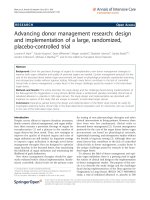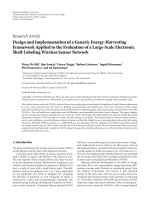Design and Implementation of VLSI Systems_Lecture 03: Cmos Fabrication potx
Bạn đang xem bản rút gọn của tài liệu. Xem và tải ngay bản đầy đủ của tài liệu tại đây (1.96 MB, 79 trang )
Design and Implementation of
VLSI Systems
Lecture 03
Thuan Nguyen
Faculty of Electronics and Telecommunications,
University of Science, VNU HCMUS
Spring 2011
1
LECTURE 03: CMOS FABRICATION
2
Fabricating One Inverter
1
Layout & Design Rule Check
2
Stick Diagram
3
Euler path
4
LECTURE 03: CMOS FABRICATION
3
Fabricating One Inverter
1
Layout & Design Rule Check
2
Stick Diagram
3
Euler path
4
4
REVIEW
n+
p
GateSource Drain
bulk Si
SiO
2
Polysilicon
n+
Body
SiO
2
n
GateSource Drain
bulk Si
Polysilicon
p+ p+
nMOS pMOS
WAFER PREPARATION
5
CMOS FABRICATION
CMOS transistors are fabricated on silicon wafer
Lithography process similar to printing press
On each step, different materials are deposited or
etched
Easiest to understand by viewing both top and cross-
section of wafer in a simplified manufacturing
process
6
EXAMPLE: INVERTER
7
8
Cross-Section View
Top View
n+
p substrate
p+
n well
A
Y
GND
V
DD
n+p+
substrate tap
well
tap
n+ p+
GND V
DD
Y
A
substrate tap
well tap
nMOS transistor
pMOS transistor
INVERTER CROSS-SECTION
Typically use p-type substrate for nMOS
transistors
Requires n-well for body of pMOS transistors
n+
p substrate
p+
n well
A
Y
GND
V
DD
n+
p+
SiO
2
n+ diffusion
p+ diffusion
polysilicon
metal1
nMOS transistor pMOS transistor
9
WELL AND SUBSTRATE TAPS
Substrate must be tied to GND and n-well to V
DD
Metal to lightly-doped semiconductor forms poor
connection called Shottky Diode
Use heavily doped well and substrate contacts /
taps
n+
p substrate
p+
n well
A
Y
GND
V
DD
n+p+
substrate tap
well
tap
n+ p+
10
INVERTER MASK SET
Transistors and wires are defined by masks
Cross-section taken along dashed line
GND V
DD
Y
A
substrate tap
well tap
nMOS transistor
pMOS transistor
11
DETAILED MASK VIEWS
Six masks
n-well
Polysilicon
n+ diffusion
p+ diffusion
Contact
Metal
Metal
Polysilicon
Contact
n+ Diffusion
p+ Diffusion
n well
12
FABRICATION
Chips are built in huge factories called fabs
Contain clean rooms as large as football fields
Courtesy of International
Business Machines Corporation.
Unauthorized use not permitted.
13
FABRICATION STEPS
Start with blank wafer
Build inverter from the bottom up
First step will be to form the n-well
Cover wafer with protective layer of SiO
2
(oxide)
Remove layer where n-well should be built
Implant or diffuse n dopants into exposed wafer
Strip off SiO
2
p substrate
14
OXIDATION
Grow SiO
2
on top of Si wafer
900 – 1200 C with H
2
O or O
2
in oxidation furnace
p substrate
SiO
2
15
PHOTORESIST
Spin on photoresist
Photoresist is a light-sensitive organic polymer
Softens where exposed to light
p substrate
SiO
2
Photoresist
16
LITHOGRAPHY
Expose photoresist through n-well mask
Strip off exposed photoresist
p substrate
SiO
2
Photoresist
17
ETCH
Etch oxide with hydrofluoric acid (HF)
Seeps through skin and eats bone; nasty stuff!!!
Only attacks oxide where resist has been exposed
p substrate
SiO
2
Photoresist
18
STRIP PHOTORESIST
Strip off remaining photoresist
Use mixture of acids called piranah etch
Necessary so resist doesn’t melt in next step
p substrate
SiO
2
19
N-WELL
n-well is formed with diffusion or ion
implantation
Diffusion
Place wafer in furnace with arsenic gas
Heat until As atoms diffuse into exposed Si
Ion Implanatation
Blast wafer with beam of As ions
Ions blocked by SiO
2
, only enter exposed Si
n well
SiO
2
20
STRIP OXIDE
Strip off the remaining oxide using HF
Back to bare wafer with n-well
Subsequent steps involve similar series of steps
p substrate
n well
21
POLYSILICON
Deposit very thin layer of gate oxide
< 20 Å (6-7 atomic layers)
Chemical Vapor Deposition (CVD) of silicon layer
Place wafer in furnace with Silane gas (SiH
4
)
Forms many small crystals called polysilicon
Heavily doped to be good conductor
Thin gate oxide
Polysilicon
p substrate
n well
22
POLYSILICON PATTERNING
Use same lithography process to pattern polysilicon
Polysilicon
p substrate
Thin gate oxide
Polysilicon
n well
23
SELF-ALIGNED PROCESS
Use oxide and masking to expose where n+ dopants
should be diffused or implanted
N-diffusion forms nMOS source, drain, and n-well
contact
p substrate
n well
24
N-DIFFUSION
Pattern oxide and form n+ regions
Self-aligned process where gate blocks diffusion
Polysilicon is better than metal for self-aligned
gates because it doesn’t melt during later
processing
p substrate
n well
n+ Diffusion
25









